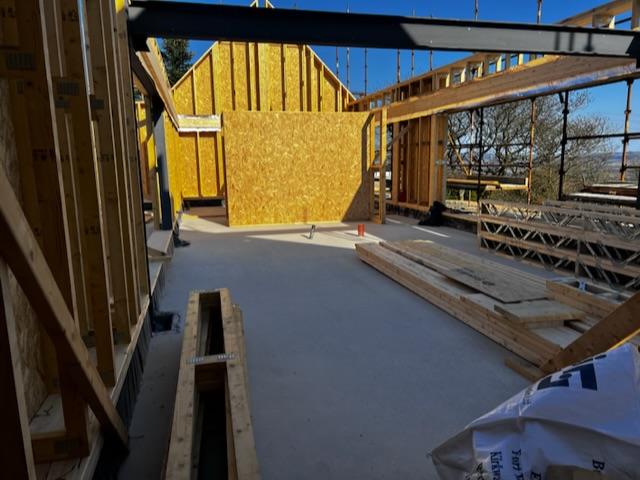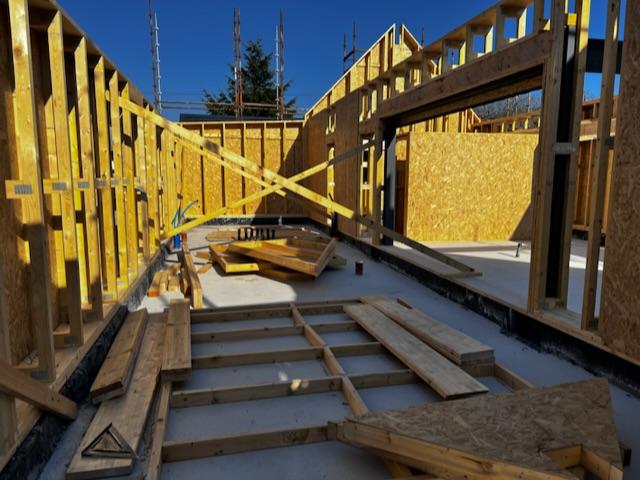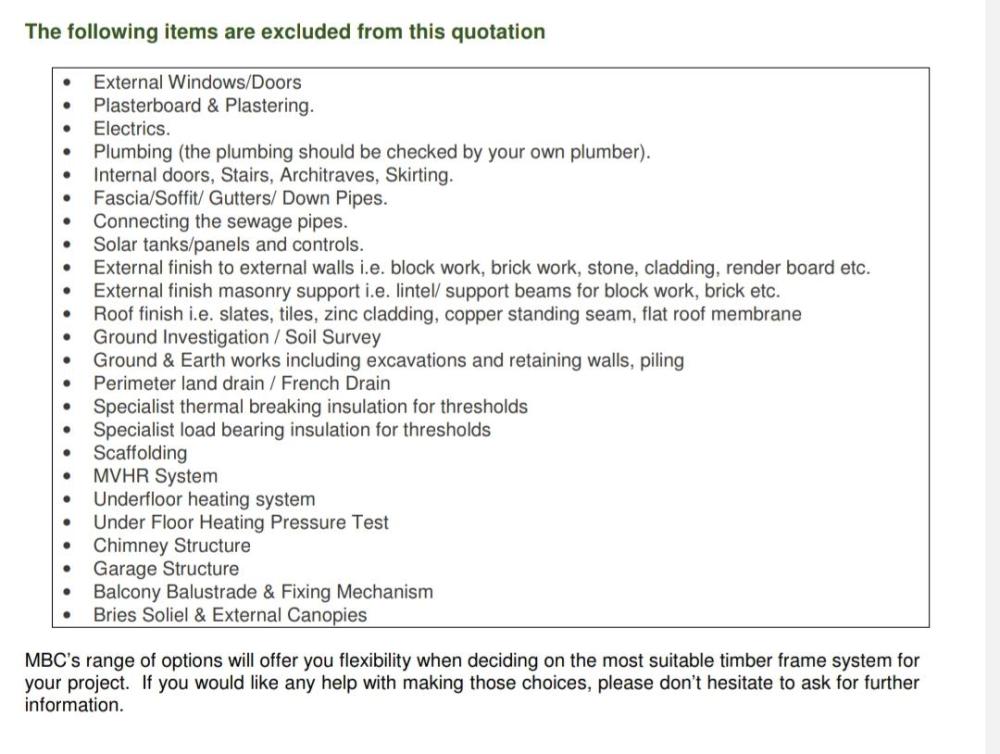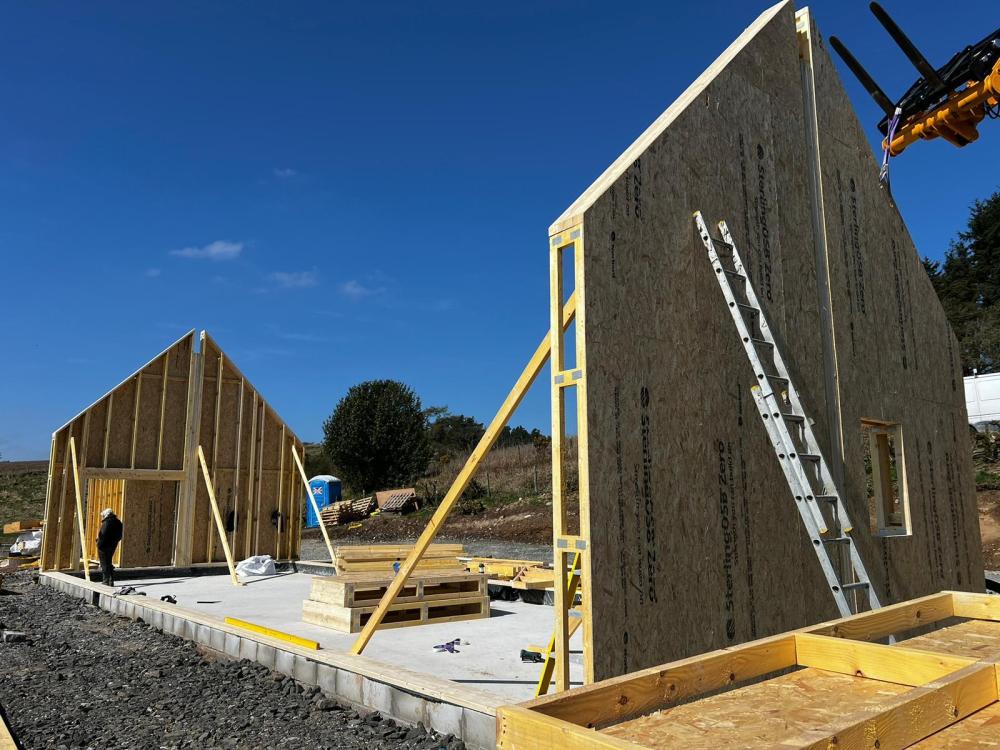Leaderboard
Popular Content
Showing content with the highest reputation on 04/21/23 in all areas
-
What a first week of my self-build (kit erection phase) Let me tick off the excitement: 1. Kit arrived ✔️ 2. kit fell off tele-handler ✔️ 3. I had a massive row with the company owner ✔️ 4. damage wasn’t too bad and all fixed now ✔️ 5. windows arrive a day early which no one was expecting same day as scaffolding going up. We debate what to do. I raise concerns about windows getting damaged kit company decide to off-load ✔️ 6. windows get damaged ✔️ 7. everyone denies it was them and they would all 100% own up to it if they did it ✔️ 8. i have a very calm discussion with company owner this time but he still threatens to stop all work. We kiss and make up ✔️ 9. he visits site and we agree damage repairable so window will be installed and igu replaced along with damaged cladding 10. Impatient portaloo driver drives down culvert. Portaloo company promise to get a manager to call me no one does. ✔️ However, in roughly four days the kit is up. Internal walling started and it looks beautiful so dead pleased.3 points
-
2 points
-
Can i suggest that it isn't as simple (one way or the other,) as some are suggesting here? The client, as most, is doing this for the first and probably only time, so doesn't necessarily know the pitfalls, or that drawings can be proposed and approved. Asking an amateur client to approve technical drawings can be seen as offloading responsibility, so isn't standard. Mistakes happen. I think i might have measured to block instead of timber too. When projects are subdivided into multiple responsibilities it saves the client a huge amount of money but they take on risk. This is an interface that was liable to go wrong. As I see it: If (and only if) the window company can fit it so that it isn't substandard then there isn't much of a claim. Maximum claim would be the cost of remedial and adaptions not by the window co. Plus you could argue for 0.5m2 ,or whatever, less window area. If you went legal on this, that is all you would get. Similarly verbal agreements, which 'aren't worth the paper they are printed on'. Sorry. Building is very difficult and there are risks.2 points
-
Hello all. A bit of technical stuff and a few tips on self building an insulated Kore (say) slab. Yes spot on. For a bit of fun here is an bit more of an explanation as to why and what is more important (in my view) for insulated raft design and construction on self builds. Roughly the plate load test involves a stiff metal plate, usually 300, 450 or 600mm square, a jack and a strain gauge and a load gauge (ring). The plate goes on the ground, and you jack against something heavy. You can create a big cradle weighed with kentledge.. expensive for smaller stuff or you can use a 16 tonne excavator to provide the kentledge. Excavator is the easy way as you drive it about.. if you have the room. You start to jack measure the amount the plate sinks by at what load, plot a graph etc and from that you derive what is called the CBR ratio (California Bearing Ratio) based as a percentage value. The CBR value is a number that is often desired for highway design. In a domestic context we may want to know this if say we are building a few houses and the shared access is to be adopted by the Highways agency or for some reason the fire brigade have a particular requirement for access during a fire.. they need to know the access will not sink under the weight of a turn table ladder.. you would have to have an exceptional site for this.. but just to mention anyway. Another time you may need to know the CBR ratio is if you are doing piling, need a heavy rig and need to design a piling matt for the rig to safely get in and do the job. The piling Contractor will do due dilligance and often ask for this number especially if they are designing the mat. If you find you get stuck on this there is the option of proof rolling. Here we may run a roller with a dead axle weight of 5 tonnes over the ground.. if it moves about like pastry then we know it is not promising. Now a key thing about the CBR (plate) test is that it only gathers good information down to 300 to 600mm, much depends on the size of the plate and the ground you are testing. The pressure / stress the plate exerts on the ground is roughly the shape of a slightly extended (droopy) light bulb (incandescent). Lastly it is possible using some rules of thumb, charts to roughly convert the CBR value to a value that is roughly equivalent to how elastic a material is called the modulus of elasticity and this is good as we now have units that are compatible with our hard core, slab insulation and concrete slab above.. not quite but closer. But on an insulated raft we are probaly using an insulation 300mm thick on 150 - 300 mm of well compacted hardcore. These spread the load a lot so the underlying formation ground is much more evenly loaded. The CBR value is now not really that useful any more to us on BH. What is useful is the value the SE puts on the soil they see in the hole as this gives them the allowable (presumed) bearing capacity of the ground. Often you see a value of 100 - 120 kN/m^2 in decent clay soils. That value equates to you being able to put about ten tonnes per square metre on the ground with the expectation you might get some 15 -25mm settlement in a clay soil. Houses are designed to move about a bit. Now if we know the allowable bearing capacity of the underlying soil, know we are using good well compacted hardcore, know what kind of insulation thickness we need and roughly what kind of concrete slab is going on top we can then design all these layers for the loads. What 99% of the time drives the design (Kore etc) is the slab loadings (slab point loadings / spread out loads) and how these interact with the insulation directly below. This is the critical bit as it drives slab thickness, amount of rebar required and the complexity of the slab / rebar and that is one place where money can be lost. The SE then iterates the design to get the most economic slab by balancing rebar, concrete thickness, concrete strength, concrete shirinkage (movement joints, water bars if applicable) and the underlying layers of insulation etc. OK. Things some you can look / think about when doing an insulated slab to set you on your way for a good job. 1/ When you excavate out the ground to the level that you are going to start from.. called the formation level look after the virgin ground surface, be quick to get a covering layer on it if say clay or friable chalk to stop it softening in the rain / frost or drying out too much. remember that value of 100 kN/m^2 .. if you soften the top 50 -150mm that bit it will move later. The last time that soil may have seen daylight could be some 100k years ago so treat it gently. 2/ Lay your hardcore in thin layers 100 -150mm thick and get a good whacker. Take extra care at corners.. try and get the compaction even.. no soft spots but also no really hard spots. Hard spots can break the back of a foundation.. strip foundations can suffer in particular if you have say a big boulder that does not move. What you are trying to go is to create a platform that moves up and down in an even way. Rafts are less succeptible but never the less. 3/ Often you need to run drains under and that involves excavating a trench and back filling. The objective here is to try and backfill so the filling is about as squashy as the ground next to it. If you were to say backfill with a lean mix 10N concrete you create a really hard spot on a line that invites a floor slab to crack, if you chuck disturbed clay back in that has got wet you'll now have a nice soft line under the slab. Hope this helps someone.2 points
-
When we purchased our plot in early 2020, I decided to do the conveyancing myself (as I'm basically a tight-arse). I didn't want to pay a solicitor to take months to do something I could easily do myself. Having completed that successfully, the purchase was finalised, and I then filled in the SDLT form and sent off a cheque for the tax that I believed was due. At that point, being aware that this was a second property, I calculated that we owed SDLT at the higher rate, so £5,000 on a plot purchased for £150,000. Skip forward to September 2022, perusing on Buildhub I discover that a building plot is not necessarily a residential property for the purposes of tax. News to me! I went back to HMRC's website, and learned that if the plot was non-residential, then the tax I owed would have been £0 (as the threshold starts at £150,001). As the plot we bought had previously been an agricultural field, prior to the vendor having obtained planning consent, then it was indeed non-residential for tax purposes. I contacted HMRC's helpline to discuss, and the chap I spoke to kindly explained that I could write in and ask them to repay me. I'm not sure whether he was aware or not, but at that point there was actually 0% chance of HMRC repaying us. The rules said that I had only 12 months from the date of completion (June 2020) to revise my SLDT submission. After that, tough luck. Any incorrectly paid tax would not be repaid. HMRC replied to my first letter, rejecting my request on the grounds that I had not quoted the piece of law I was relying on to ask for it. I then spent an entire weekend researching caselaw on situations such as mine. What an exercise in disappointment that was, to put it mildly. I read every single published judgement on SDLT cases for the previous 5 years, as well as the relevant regulations themselves, and concluded that there was simply no basis for me to persuade HMRC to repay us. I was crestfallen, and had to admit to HWMBO that I had gifted £5k to the Treasury out of my own ignorance, and my unwillingness to pay legal fees. Still, I decided that it was worth one final try, and I sat down in January to write the mother of all letters to try to persuade HMRC to repay us. I explained my mistake, cited the regulations, and asked if they could exercise discretion to allow a late amendment to the SDLT1 form on the grounds that they had themselves checked the form at the time and had not identified my error, despite there having been enough information on the form for them to have reasonably suspected that the property was not residential. I said that if they would not do that, would they please consider opening an enforcement case against us so that they could review whether we had paid the right amount of tax, and calculate for themselves what we owed (which was the only legal route that would allow them to revise the SLDT1 form beyond the time limit). Then I went for the heartstrings, saying that we really couldn't afford to gift this money to the Treasury, and if they could please see their way to reimburse us, we would be eternally grateful. A couple of weeks ago HWMBO found a credit in his bank account of £5089.00 with a reference of 'HMRC SDLT'. They had not only repaid us, but added interest for the time they had had the money. They haven't written to us to say why they decided to do this, so I've no idea which part of the letter was effective, but it feels churlish to question it. A very salutary lesson in there for me. And perhaps for some of you too.1 point
-
1 point
-
Indefinitely I believe. Pre-digitalisation they’ll have physical copies archived. Some councils will allow you to request access which they can scan and make available to you.1 point
-
Neither of those seem to serve my area (Herts/Essex borders). I have tried every MCS registered organisation within 15 miles, and many beyond, but admittedly none that do not claim to work either in my area or nationwide.1 point
-
The house is a late 70s detached in the South West, with good insulation and 20years old double glazing. It has a B EPC. Currently it has a Vaillant boiler and a Johnson and Starley warm air unit. The hot water causes the J&S unit to turn and blow the warm air it collects from the boiler's hot water. It then it heats the house. Or doesn't if you run the boiler cooler to save energy/money. Hardly any warm air reaches the upstairs. Not that that is a big problem with electric blankets. We have solar panels (3.9 kW) from 2014 so relatively unsophisticated and a Tesla battery. The house, in winter is heated by gas and the battery is charged up on cheap overnight electricity. The house runs on just the panels and battery for 9.5 months of the year and the rest is mainly gas and a bit of electricity thrown in. 1.5kWhs are generated in December and 2.5in January. Have 15kWh altogether per day. An Electric car is charged on cheap rate too and we have about 8.5Kwhs electric for heating before it goes up to 41p a kWh but can run the gas downstairs if needed. The hot water is gas. We will probably keep the gas but steadily replace it, then use it in an emergency. Initially I will test the water on here to work out the best way to adapt the warm air heating (WAH) to an Air-to-Air heat pump. (If you are not familiar with A2A they are Air conditioning units running in reverse.) The outside unit (3 connections minimum) will be mounted on the end wall with short run to the lounge unit (2.5Kw) and one other connection has a run of 7 metres to the "warm air distribution point" in the centre of the house. see photo Plenum. This will have to be modified to accept a "Ducted" unit, unless anybody knows better. The upstairs unit will only heat 1 room at a time (bathroom/study mainly) and therefore can be relatively low powered. 2.5kW again?1 point
-
Lights above a worktop I set 600mm from the wall, in other words in line with the edge of the worktop so they may not be exactly "square". Any further out to get the spacing to look better risks you working in your own shaddow.1 point
-
Welcome Katie, I'll throw in my penny's worth...I'm pretty clueless about design, but believe that a particular site can accommodate lots of designs - many of which don't suit the site. Views, orientation, likely usage of outside spaces, slopes etc. are what drives the design just as much as a desirable internal layout. Many on this forum are experienced in this area, or are naturally good at it, and this renders an architect less useful. I chose to work with one (and a planning consultant too) up to the planning stage (May 19th is my Determination Date 🤞) since I wanted someone to both hold my hand (I'm single) and provide experience. They weren't cheap and of course it's possible I could have come up with a good successful design without them. It's also interesting how taking time over the process helps to provide perspective on decisions - don't rush it. Good luck M1 point
-
In fairness this is a great forum with mountains of real life knowledge, throughout my build of about 4 years, even as a retired builder, I have learnt loads of stuff so bring on the questions 👍1 point
-
That's exactly what I do, I charge the batteries every day on the off peak, then export down to 60% during the peak period, any excess once the batteries are charged is exported.1 point
-
😂 none of it down to me but all of it up to me to sort. It’s like a comet flying through space with an ever growing tail of stuff to fix extending out behind it.1 point
-
That’s not how a decent justice system in a modern democracy works. Particularly in England, where many aspects of the law is effectively judge-made, it’s important for Judges to feel like they can do their job, without fear of punishment. That is because often they will be called upon to make very difficult and bold decisions. They don’t need the added pressure of punishment if they get it wrong. Believe me, it’s highly embarrassing to be overturned on appeal, that is punishment enough. Ultimately, judges are human. We all make mistakes.1 point
-
I can’t agree more with @Thorfun While you should have a look at what has achieved planning near you, don’t just copy the neighbour. You can evoke whatever the style is to improve your chances or try for something very different as councils aren’t averse to this. Possibly a bit rich coming from someone who has taken a standard design and modified it a bit which is basically two rectangles with different roofs. However there’s nothing else like it anywhere nearby. His second point is the most important as I also know someone that got into a real financial hole doing exactly what you’re suggesting. He lost his plot and very nearly lost his house at one point. Clearly we don’t know your financial position and you sound like you are doing all the right research. We could have built and stayed in our previous house without bridging loans then sold up and moved into the new house. However I’m too risk averse to do that and, as it turned out, we would have got about £80k less for our house I reckon had we waited. Our old neighbour can’t sell their somewhat similar house at all in 6 months whereas we sold ours in a few weeks a year ago.1 point
-
I assume you mean £3000/m2. If so that is a healthy budget. Ours probably cost about €1900/m2 pre covid once you factor in my labour, but that was beds dressed, walls painted etc etc. That's including VAT too so an equivalent pre covid cost in sterling might be about £1500/m2. MBC were about £390/m2 in 2019 but that excludes quite lot. With the twinwall frame they have the best thought out system I know of however.1 point
-
Some more https://images.app.goo.gl/ouz15L7kAKdhHbQr5 https://images.app.goo.gl/ihJT7GnGmbvFhNdd7 https://images.app.goo.gl/in2nZx6jenNkd3uB8 https://images.app.goo.gl/Jsqm7ZP3N7nYq5Wq71 point
-
1 point
-
It's just a garage so is allowed to be on the flimsy side. Loadings about 40% less than an occupied building. Nobody doubting it I don't think.1 point
-
I'd have to say I've walked along plenty of concrete farm "roadways" when out in the countryside. If you wanted to go down that route then some local evidence of that type of agricultural access might strengthen your arm a bit. However, nearly half a kilometre of concrete road may be a bit dear. The alternative is going to be a compacted crushed stone approach but that's probably not going to be a lot better than what's there. I think I'd decide what I would prefer and then look for evidence of it's use elsewhere and argue my case a bit.....1 point
-
Interesting. It assumes that a glazing company is aware of all possible construction options, and that it was clear on detailed drawings (if they existed) or on site, that the windows were not to be in the block section. I think ggc has it right: legal action would be costly and i am confident that there is case law that would result in the award of a tiny sum. I like ggc comment about the motor industry....except that vehicles are not normally individually designed with multiple choices of parts, then assembled in a field. Get everyone working on a satisfactory solution. If you can, get something for nothing from the window people....trims or something to benefit you but easy for them.1 point
-
Take no notice of the children, an adult will be along shortly 🤣(looks good by the way 👍)1 point
-
1 point
-
1 point
-
1 point
-
1 point
-
The HSE believe that domestic gas safe folks* are competent? 🤣 *Even the ones in nationally branded colourful vans? In the real world you can fit your gas appliances if you deem yourself competent and don't make an unsafe installation. Enforcement is, by choice, nil other than failed domestic gas safe monkeys doing bad installs for cash and idiots stealing copper/bypassing gas meters. Even shoddy firms putting incompetent folks to work in multiple homes in nationally branded colourful vans don't get sanctioned. Ever.1 point
-
what an unfortunate series of cock ups. All too common and easily done. These are the things that a professional site manager/project manager would catch as they know to look out for them. You are saving the cost and not having the benefit of this experience so you can spend it elsewhere like we all do. It's a learning curve, once you start on your third there will be a lot less mistakes trust me!1 point
-
1 point
-
Last one I just bit the bullet and bought the festool (only comp who make one?) insulation cutter with dust extraction. It runs on a track and you can do 2x 100mm sheets per pass. don't forgot gapotape the edges, no bodging with foam. https://gaposhop.com/shop/ols/products/gapotape-gt10-slash-100 good practice for complying with the new regs, pictures of everything.1 point
-
If they have standard rated the invoice but declared it as 0% on the VAT return and pocketed the difference, that would be fraud and HMRC would definitely be interested. But it is much more likely that the VAT shown on the invoice went on the next VAT return and was paid over to HMRC. These days the vast majority of traders are using book-keeping software that does that automatically. You can't just "make a mistake adding it up" like the old days, you'd have to manually adjust the numbers on the computer in a way that leaves a trail and means it's easy to get caught. If that's happened then they have charged you more VAT than they should have, but they have also paid HMRC more VAT than they should have. You're out of pocket, the trader has not gained anything, and HMRC have your money. Sadly HMRC are unlikely to spend much time trying to give it back (and their powers are limited : e.g. they can't charge a penalty to someone for overcharging VAT). Which, as an aside, is why I think it's pretty unfair HMRC won't allow things like this for the self-build scheme - in the majority of cases they will have your money or be about to get it. It's also worth saying that just because a subcontractor hasn't charged VAT doesn't automatically mean the contractor shouldn't charge VAT when they charge it on. Each step in the chain is a new transaction for VAT purposes, and you can get situations where a supply is 0% rated between suppliers but then 20% rated to the final customer. Just as you can get cases where it's 20% rated between suppliers but 0% rated to the final customer. When that happens then - so long as everyone is being honest on their VAT return - none of the traders gain anything, all the "profit" on difference between amount paid and amount charged ends up with HMRC. All you can really do is pursue the action against the company, via the new director, and get them to issue the credit note and correct invoice and your refund. If the new director is not familiar with the history, it might be worth making sure they understand that all they have to do is correct the invoice and reclaim it on their next VAT return: they don't have to pay out of their own pocket. Some people struggle to grasp that! This does all assume that the company is a limited company and is still trading under the same VAT registration as before. If not then it will be more complex as they won't be able to correct a different entity's VAT returns.1 point
-
Not meaning to sound unsympathetic but your contract is struck based on you accepting their written offer when you sign on the dotted line/part with your cash. We've had a couple of relatively minor, similar, issues with suppliers and they've all been caused by wee oversights on my part where I've not fully checked the small print and that's really on me - unless there's something significant which breaches the supplier's duty of reasonable care/professional competency then I don't see you having much of a leg to stand on if you've not got approved drawings/a schedule setting out a list of agreed sizes.1 point
-
That is a very good practical question! If you have a cavity wall and using twin beams under each leaf then you can use M16 or M20 threaded rod in the web. The rods need to go as close to the top flange as you can so the nut clears the root of the web. You get the web drilled and then align the beams so the holes line up. Weave the rod through and wind on nuts so there is a nut both sides of both the webs... then you fiddle about progressivly tightening the nuts. Now you can only do that if you have a reasonably wide cavity and beam flanges not too wide as you need to get a spanner in between the beams. OR you can be really clever and bolt the rods to the first beam with a nut each side of the beam turned up tight, measure exactly where the inside of the other beam web needs to be, wind on two nuts and turn them in opposite directions so they lock... a locking nut. Then the second beam can be slid sideways onto the rods and you put the last nut on. But all this needs good planning as there are probably props etc in the way. The other easy to do it is to put a flat plate over the tops of the beams and bolt that down to the top pre drilled flanges. The plate acts like a strut. The objective of both methods is to prevent the top flange buckling sideways. Rods can be a bit of a palaver but if you have set your mind on mitigating cold bridging rods work well in this context as their cross section area is a lot less than flat plates. I'm sure there are other ways to do this? but that is some..1 point
-
Most inverter driven ones should already have that built in. Older direct on line types would probably have some crude PF correction in the form of a capacitor.1 point
-
All my suppliers of services came from direct recommendation of other people on site or I already had previous experience of them as a company, those companies are the ones I took recommendations from. There was two exceptions two exceptions to that, the company that did the roof structure and our standing seam roof covering. The roof structure company wanted a material deposit, this deposit was to be paid to the company building the roof posi rafters. I insisted the deposit would not be paid until I was copied on all correspondence with the third party company and had seen the PO issued. A final payment had to made for material prior to them starting at site. So agreed that as soon as the lorry was parked by our house I would release the funds. Which I did, they started work the next day. The other company and all other companies were paid for work and materials after the work was completed, or I purchased the materials myself and free issued on a labour only basis. How you mitigate for a company going bankrupt, is difficult. Durisol went that way after our build was completed. But having a more normal build you can at least spread your supplier base so all your eggs aren't in one basket.1 point
-
@Valentina can you clarify a few things please: How was this admission recorded? Did the defendant company tick the box on the claim form that says they "admit" the claim. Or was the admission down outside of court documents? If the defendant admitted the claim as its formal response to the claim, then you would have the right to a Court judgment against the defendant (see Civil Procedure Rule 14.1(4) https://www.justice.gov.uk/courts/procedure-rules/civil/rules/part14). That is important, because you could then convert the admission into an actual court judgment, and that will speed up the process of enforcing the Court judgment, rather than having to start a new claim. It is helpful that a first payment was made, as it evidences that at least initially the defendant thought the admission was binding. Ultimately, just because a company changes hands, does not change the company's liability to you. The director of a company is just it's agent and the shareholder is just its owner. But the company has separate legal personality, and this is not to be confused with the legal personality of the director or the agent. The liability is with the company, not the director. As the liability is with the company, not the director, it doesn't matter if you have up to date contact details of the director or not. You should communicate directly with the company in any case, by writing to the company's registered address which you can find here: https://find-and-update.company-information.service.gov.uk/1 point
-
1 point
-
Yes, it's not often done domestically, but for the sake of a few pounds it's worthwhile adding a Y-strainer on the incoming water. Ideally add others before each pump and mixer.1 point
-
Reading this thread has been a wake up call to me as feel for all those effected. I originally was keen on Durisol doing their course last year and then discovered Isotex which was my chossen route up until begin of Feb. My original contractor had changed numbers..not a good sign and so I decided I'm going to build the ICF myself and thus have decided to go Nudura who have a proven system with 8 foot by 18 inches high blocks so quick building times. Going to be placing orders next month...a long as can at least pay deposit with credit card after having reading others misfortune on here.1 point
-
A small battery helps to make the most of this tariff, but it is entirely usage dependent as to whether it's financially worthwhile. As an update, my total billed electric cost (excluding standing charges) since switching to Flux 3 weeks ago is £0.78. Not bad at all considering I've also been running the heat pump which has offset around £63 of gas usage over the same period. As heating demand disappears I'm realistically going to have to change my direct debit to ~£0 over the summer as the export will easily cover hot water and standing charges. It's a great summer tariff.1 point
-
Posting on here helps me think the problem through as my other half isn’t interested 😂 It will feed a tank in the garage after filtration and then is pumped to the house.1 point
-
0 points
-
That would be a refreshing change! I'm doing my best to encourage such 'optimal usage' and am quite pleased with the response so far. Fresh hot cakes cooked by the Sun are a delight and reasonably guilt-free. But if I baked them it would still add to the carbon problem.0 points
-
Went to site at 7am this morning, just as the windows arrived, a day early and today is scaffolding day. What is it with folk and their inability to follow clear instructions. Anyway an hour of moving stuff around and we’ve off-loaded them. Lorry driver told me he did a delivery last week to a field. Phoned his contact and the bloke went quiet and said he never achieved planning permission and forgot about the window order. 😂0 points

















